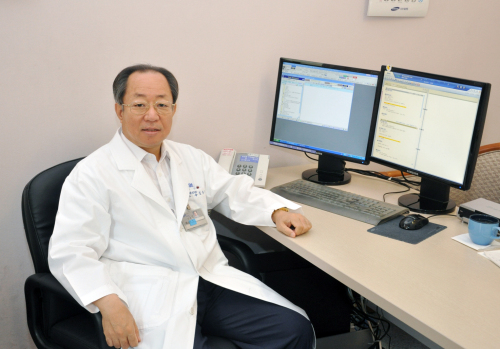What causes high risk pregnancy?
- Dancing toddler hits Youtube
- The ugliest animals in the world
- ‘Smart pain’ on rise among phone users
- Top auditor Kim Hwang-sik picked as Prime Minister nominee
- Prosecutors raid Hanwha Corp., Hanwha securities
- Ohio mom accused of giving marijuana to her baby
- [Interview] Shin's ex-aides to disclose Ra misdeeds
- 'CCTV captures ghost in pub'
- Age is just number
- Sports reporter sexually harassed in football locker room
Pregnancy is a condition that suppresses maternal immunity and prevents its rejection of the fetus. Even “normal pregnancy” is considered risky because maternal or fetal conditions are closely linked.
Improvements in blood banking, antibiotics, anesthesia and hypertension treatment have led to a reduction in maternal and fetal sickness and death rates.
Still, preconception counseling and the supplementation of folic acid are recommended for women who want to conceive. This counseling might include: An analysis of personal and family history; medical history, such as genetic disease and reproductive history; social history, such as maternal and environmental exposures and lifestyle; and work habits, such as diet and exercise.
After the diagnosis of pregnancy, initial prenatal evaluation and follow-up prenatal care are necessary. Initial prenatal evaluations include history, physical and cervical examination, and laboratory tests.
Subsequent prenatal visits have been traditionally scheduled at intervals of four weeks until 28 weeks and then every two weeks until 36 weeks, then weekly thereafter until delivery.
Further prenatal evaluation includes the testing of fetal heart rate, fetal size, amount of amniotic fluid, fetal position, fetal activity and placenta and maternal blood pressure, maternal body weight, and maternal symptoms (such as headaches), uterine size and vaginal examination.
There are many high risk factors in pregnancy. So it is necessary to identify those who are at risk and then to provide the specific care required to prevent maternal or fetal death or damage.
A “high-risk” pregnancy is defined as one in which the mother or the fetus has a significantly increased chance of death or disability, when compared with a “low-risk” pregnancy in which an optimal outcome is expected for both.

There are many high risk factors in pregnancy. High-risk pregnancy is divided into socioeconomic, demographic, and medical categories.
Socioeconomic factors: Inadequate finances, poor housing, severe social problems, malnutrition and parental occupation.
Demographic factors: Maternal age under 16 or over 35, overweight or underweight prior to pregnancy, height less than 152cm and a family history of severe inherited disorders.
Medical factors: Maternal medical history (including conditions such as severe heart or lung disease, diabetes and genetic problems,) obstetrical history and current obstetrical status and habits.
Habits such as smoking during pregnancy, regular alcohol intake and drug abuse are also known risk-factors.
From the obstetric viewpoint, maternal survival has been of primary importance and in rare instances even living fetuses have been sacrificed to ensure the mother’s safety.
A continuous and thorough assessment of mother and fetus during pregnancy and delivery is an important means of contributing toward their future quality of life.
By Kim Jong-hwa, M.D., Ph.D
The writer is a specialist of obstetrics and gynecology at Samsung Medical Center. Ed.
Improvements in blood banking, antibiotics, anesthesia and hypertension treatment have led to a reduction in maternal and fetal sickness and death rates.
Still, preconception counseling and the supplementation of folic acid are recommended for women who want to conceive. This counseling might include: An analysis of personal and family history; medical history, such as genetic disease and reproductive history; social history, such as maternal and environmental exposures and lifestyle; and work habits, such as diet and exercise.
After the diagnosis of pregnancy, initial prenatal evaluation and follow-up prenatal care are necessary. Initial prenatal evaluations include history, physical and cervical examination, and laboratory tests.
 |
| Kim Jong-hwa |
Subsequent prenatal visits have been traditionally scheduled at intervals of four weeks until 28 weeks and then every two weeks until 36 weeks, then weekly thereafter until delivery.
Further prenatal evaluation includes the testing of fetal heart rate, fetal size, amount of amniotic fluid, fetal position, fetal activity and placenta and maternal blood pressure, maternal body weight, and maternal symptoms (such as headaches), uterine size and vaginal examination.
There are many high risk factors in pregnancy. So it is necessary to identify those who are at risk and then to provide the specific care required to prevent maternal or fetal death or damage.
A “high-risk” pregnancy is defined as one in which the mother or the fetus has a significantly increased chance of death or disability, when compared with a “low-risk” pregnancy in which an optimal outcome is expected for both.

There are many high risk factors in pregnancy. High-risk pregnancy is divided into socioeconomic, demographic, and medical categories.
Socioeconomic factors: Inadequate finances, poor housing, severe social problems, malnutrition and parental occupation.
Demographic factors: Maternal age under 16 or over 35, overweight or underweight prior to pregnancy, height less than 152cm and a family history of severe inherited disorders.
Medical factors: Maternal medical history (including conditions such as severe heart or lung disease, diabetes and genetic problems,) obstetrical history and current obstetrical status and habits.
Habits such as smoking during pregnancy, regular alcohol intake and drug abuse are also known risk-factors.
From the obstetric viewpoint, maternal survival has been of primary importance and in rare instances even living fetuses have been sacrificed to ensure the mother’s safety.
A continuous and thorough assessment of mother and fetus during pregnancy and delivery is an important means of contributing toward their future quality of life.
By Kim Jong-hwa, M.D., Ph.D
The writer is a specialist of obstetrics and gynecology at Samsung Medical Center. Ed.

No comments:
Post a Comment